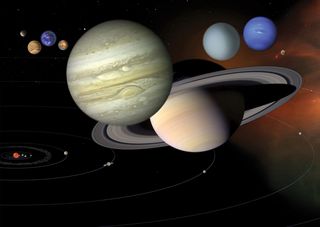Planets
solarsystem.nasa.gov

Our solar system is a vast place, with lots of mostly empty space between planets. But out there are comets, asteroids and more rocky, frozen objects (including dwarf planets) yet to be discovered in the Kuiper Belt and Oort Cloud.
(Image: © NASA)
The solar system is made up of the sun and everything that orbits around it, including planets, moons, asteroids, comets and meteoroids. It extends from the sun, called Sol by the ancient Romans, and goes past the four inner planets, through the Asteroid Belt to the four gas giants and on to the disk-shaped Kuiper Belt and far beyond to the teardrop-shaped heliopause. Scientists estimate that the edge of the solar system is about 9 billion miles (15 billion kilometers) from the sun. Beyond the heliopause lies the giant, spherical Oort Cloud, which is thought to surround the solar system.
Discovery
For millennia, astronomers have followed points of light that seemed to move among the stars. The ancient Greeks named them planets, meaning “wanderers.” Mercury, Venus, Mars, Jupiter and Saturn were known in antiquity, and the invention of the telescope added the Asteroid Belt, Uranus, Neptune, Pluto and many of these worlds’ moons. The dawn of the space age saw dozens of probes launched to explore our system, an adventure that continues today. Only one spacecraft so far, Voyager 1, has crossed the threshold into interstellar space.
The discovery of Eris kicked off a rash of new discoveries of dwarf planets, and eventually led to the International Astronomical Union revising the definition of a “planet.” The revision changed Pluto’s status from planet to dwarf planet in 2006, a decision that remains controversial – especially after the New Horizons mission found immense geological variety on the world in 2015. [Infographic: Structure of the Solar System]
Astronomers are now hunting for another planet in our solar system, a true ninth planet, after evidence of its existence was unveiled on Jan. 20, 2016. The so-called “Planet Nine,” as scientists are calling it, is about 10 times the mass of Earth and 5,000 times the mass of Pluto.
Formation
Many scientists think our solar system formed from a giant, rotating cloud of gas and dust known as the solar nebula. As the nebula collapsed because of its gravity, it spun faster and flattened into a disk. Most of the material was pulled toward the center to form the sun. Other particles within the disk collided and stuck together to form asteroid-sized objects named as planetesimals, some of which combined to become the asteroids, comets, moons and planets.
The solar wind from the sun was so powerful that it swept away most of the lighter elements, such as hydrogen and helium, from the innermost planets, leaving behind mostly small, rocky worlds. The solar wind was much weaker in the outer regions, however, resulting in gas giants made up mostly of hydrogen and helium.
The sun
The sun is by far the largest object in our solar system, containing 99.8 percent of the solar system’s mass. It sheds most of the heat and light that makes life possible on Earth and possibly elsewhere. Planets orbit the sun in oval-shaped paths called ellipses, with the sun slightly off-center of each ellipse. NASA has a fleet of spacecraft observing the sun to learn more about its composition, and to make better predictions about solar activity and its effect on Earth.












